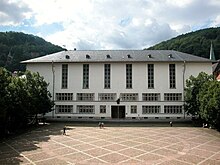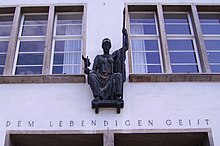New University (Heidelberg)




The New University is a listed building complex of the University of Heidelberg in Heidelberg's old town , on Universitätsplatz , Grabengasse and Seminarstraße. The three-wing complex is not far from the Old University, which was built between 1712 and 1735 . The main entrance and the new auditorium are located in the wing of the building that delimits Universitätsplatz to the south . The New University was built in two construction phases. In 1930/31 the main building and the west wing were built and in 1934 the south wing. The design and construction plans come from Karl Gruber , who was also the construction manager for the project.
history
The initiator for the construction of the New University was the American Jacob Gould Schurman , former student at Heidelberg University and later Ambassador of the United States of America in Berlin. Schurman started a fundraising campaign to create the lecture hall capacity that was urgently needed in Heidelberg. Schurman was also able to win Walter P. Chrysler and John D. Rockefeller as patrons for the undertaking . In December 1928 Schurmann was able to present the result of his fundraising campaign of more than half a million dollars.
Construction work on the new building began in 1930. The architect Karl Gruber from Gdańsk designed the new university complex as "contemporary and functional architecture, but not in the spirit of modernity ", which realized its architectural visions using the technical, then new, building materials of steel , glass and reinforced concrete .
Building description
Gruber worked with traditional building materials. The building complex of the New University is a plastered masonry building with a hipped roof . The roof and the dormers are covered with shingles made of slate . The basement of the three-winged building complex is clad with grayish, unspatted travertine at a gradual height towards Universitätsplatz, Grabengasse and Seminarstraße .
Broad steps lead from Universitätsplatz via a large forecourt to the south-facing main building of the New University that delimits the square. The entrance portal, steps, forecourt, door reveal and lintel of the portal were also made from unspatted travertine.
There is a passage from Grabengasse to the inner courtyard of the New University. Here, too, the architect chose the grayish, unspatted travertine for the cladding of the wall surfaces, reveals and lintels on the courtyard and street side, as well as for the flooring in the passage area to the courtyard.
Gruber repeated the use of travertine as a structural and visual structuring element on all window reveals, door reveals, lintels, exterior window sills and the surrounding cornices on the facade of the New University.
The bronze sculpture of Pallas Athena above the portal was created by Karl Albiker . With its 14 lecture halls, the New Aula and the Senate Hall , the New University is the largest lecture hall building on the campus in Heidelberg's old town .
The witch tower
The Hexenturm , formerly part of the city fortifications from the 13th century, was incorporated into the architecture of the newly built building complex and connects the building sections that are located at right angles on Grabengasse and Seminarstraße, whereby the medieval tower building with its open staircase connecting the two building complexes has become a link.
Changes during the time of National Socialism
During the time of National Socialism in Germany, the bronze of Pallas Athena above the main entrance of the New University was exchanged for the imperial eagle with a swastika . The inscription "The living spirit", formulated by Friedrich Gundolf , was changed to "The German spirit". A bust of Jacob Gould Schurman, which was placed in his honor in the Neue Aula , was replaced by a bust of Hitler .
The time after the university reopened
After the end of the Second World War , the National Socialist dictatorship and the reopening of the university in the winter semester 1945/46, the bronze of Pallas Athena was put back in its designated place above the main entrance, and the bust of Jacob Gould Schurman was also placed in the New university back.
In the years from 2009 to 2011, the New University was fundamentally modernized, the technical prerequisites for modern teaching were created and with the help of financial support from well-known donors, the inner courtyard was also redesigned.
Organ of the new auditorium
The large organ in the New Aula was built in 1964 by the Weigle organ building company. The instrument initially had 53 stops on three manual works and a pedal. In 2011 the instrument was reorganized and expanded by the organ builder Thomas Jann and the organ building workshop Mühleisen (Leonberg). Today the instrument has 63 stops on three manual works and a pedal, and a further 6 stops in a solo work, which can be freely coupled to all manuals and the pedal.
|
|
|
|
|
|||||||||||||||||||||||||||||||||||||||||||||||||||||||||||||||||||||||||||||||||||||||||||||||||||||||||||||||||||||||||||||||||||||||||||||||||||||||||||||||||||||||||||||||||||||||||||||||||||||||||||||||||||||||||||||||||||||||||||||||||||||||||||||||||||
- annotation
- (n) = new register (2011)
gallery
literature
- State Office for Monument Preservation (publisher): Monument topography Federal Republic of Germany, cultural monuments in Baden-Württemberg, city district of Heidelberg , Thorbecke-Verlag 2013, ISBN 978-3-7995-0426-3
Individual evidence
- ↑ How Jacob Gould Schurman donated a new lecture hall building to Ruperto Carola . Press release No. 3/2009 from Heidelberg University, February 9, 2009
- ↑ Information about the organ on the website of the organ builder; comprehensive information in the commemorative publication for the organ consecration
Web links
Coordinates: 49 ° 24 ′ 37.6 " N , 8 ° 42 ′ 23.8" E









